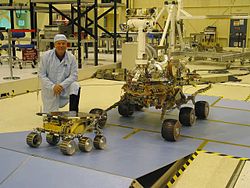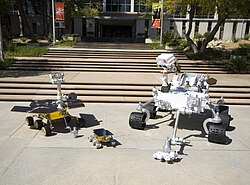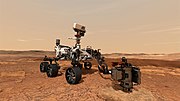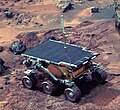- Size comparison of the Mars Exploration Rover (rear) and the Sojourner rover
- Mars Science Laboratory (R); Mars Exploration Rover (L) and Sojourner rover (centre)
- Mars Exploration Rover
Related Research Articles

Jet Propulsion Laboratory (JPL) is a federally funded research and development center in Pasadena, California, United States. Founded in 1936 by Caltech researchers, the laboratory is now owned and sponsored by the National Aeronautics and Space Administration (NASA) and administered and managed by the California Institute of Technology.

2001 Mars Odyssey is a robotic spacecraft orbiting the planet Mars. The project was developed by NASA, and contracted out to Lockheed Martin, with an expected cost for the entire mission of US$297 million. Its mission is to use spectrometers and a thermal imager to detect evidence of past or present water and ice, as well as study the planet's geology and radiation environment. It is hoped that the data Odyssey obtains will help answer the question of whether life existed on Mars and create a risk-assessment of the radiation that future astronauts on Mars might experience. It also acts as a relay for communications between the Curiosity rover, and previously the Mars Exploration Rovers and Phoenix lander, to Earth. The mission was named as a tribute to Arthur C. Clarke, evoking the name of his and Stanley Kubrick's 1968 film 2001: A Space Odyssey.

Mars Pathfinder is an American robotic spacecraft that landed a base station with a roving probe on Mars in 1997. It consisted of a lander, renamed the Carl Sagan Memorial Station, and a lightweight, 10.6 kg (23 lb) wheeled robotic Mars rover named Sojourner, the first rover to operate outside the Earth–Moon system.

Opportunity, also known as MER-B or MER-1, is a robotic rover that was active on Mars from 2004 until 2018. Opportunity was operational on Mars for 5111 sols. Launched on July 7, 2003, as part of NASA's Mars Exploration Rover program, it landed in Meridiani Planum on January 25, 2004, three weeks after its twin, Spirit (MER-A), touched down on the other side of the planet. With a planned 90-sol duration of activity, Spirit functioned until it got stuck in 2009 and ceased communications in 2010, while Opportunity was able to stay operational for 5111 sols after landing, maintaining its power and key systems through continual recharging of its batteries using solar power, and hibernating during events such as dust storms to save power. This careful operation allowed Opportunity to operate for 57 times its designed lifespan, exceeding the initial plan by 14 years, 47 days. By June 10, 2018, when it last contacted NASA, the rover had traveled a distance of 45.16 kilometers.

A Mars rover is a remote-controlled motor vehicle designed to travel on the surface of Mars. Rovers have several advantages over stationary landers: they examine more territory, they can be directed to interesting features, they can place themselves in sunny positions to weather winter months, and they can advance the knowledge of how to perform very remote robotic vehicle control. They serve a different purpose than orbital spacecraft like Mars Reconnaissance Orbiter. A more recent development is the Mars helicopter.
The RAD6000 radiation-hardened single-board computer, based on the IBM RISC Single Chip CPU, was manufactured by IBM Federal Systems. IBM Federal Systems was sold to Loral, and by way of acquisition, ended up with Lockheed Martin and is currently a part of BAE Systems Electronic Systems. RAD6000 is mainly known as the onboard computer of numerous NASA spacecraft.

Mars Science Laboratory (MSL) is a robotic space probe mission to Mars launched by NASA on November 26, 2011, which successfully landed Curiosity, a Mars rover, in Gale Crater on August 6, 2012. The overall objectives include investigating Mars' habitability, studying its climate and geology, and collecting data for a human mission to Mars. The rover carries a variety of scientific instruments designed by an international team.
The RAD750 is a radiation-hardened single-board computer manufactured by BAE Systems Electronics, Intelligence & Support. The successor of the RAD6000, the RAD750 is for use in high-radiation environments experienced on board satellites and spacecraft. The RAD750 was released in 2001, with the first units launched into space in 2005.

A Mars landing is a landing of a spacecraft on the surface of Mars. Of multiple attempted Mars landings by robotic, uncrewed spacecraft, ten have had successful soft landings. There have also been studies for a possible human mission to Mars including a landing, but none have been attempted. Soviet Union’s Mars 3, which landed in 1971, was the first successful Mars landing. As of 2023, the Soviet Union, United States and China have conducted Mars landings successfully.

Curiosity is a car-sized Mars rover exploring Gale crater and Mount Sharp on Mars as part of NASA's Mars Science Laboratory (MSL) mission. Curiosity was launched from Cape Canaveral (CCAFS) on November 26, 2011, at 15:02:00 UTC and landed on Aeolis Palus inside Gale crater on Mars on August 6, 2012, 05:17:57 UTC. The Bradbury Landing site was less than 2.4 km (1.5 mi) from the center of the rover's touchdown target after a 560 million km (350 million mi) journey.
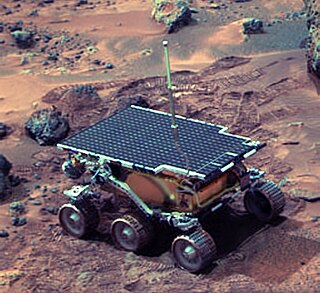
Sojourner is a robotic Mars rover that landed in the Ares Vallis channel in the Chryse Planitia region of the Oxia Palus quadrangle on July 4, 1997. Sojourner was operational on Mars for 92 sols. It was the first wheeled vehicle to rove on a planet other than Earth and formed part of the Mars Pathfinder mission.
Spacecraft and their missions are given descriptive, sometimes technical names, by scientists, engineers and administrators involved. Space agencies sometimes open the naming up to the public or to school children in the form of essay contests.

Opportunity is a robotic rover that was active on the planet Mars from 2004 to 2018. Launched on July 7, 2003, Opportunity landed on Mars' Meridiani Planum on January 25, 2004, at 05:05 Ground UTC, three weeks after its twin Spirit (MER-A), also part of NASA's Mars Exploration Rover Mission, touched down on the other side of the planet. While Spirit became immobile in 2009 and ceased communications in 2010, Opportunity exceeded its planned 90 sol duration of activity by 14 years 46 days. Opportunity continued to move, gather scientific observations, and report back to Earth until 2018. What follows is a summary of events during its continuing mission.

Sol is a solar day on Mars; that is, a Mars-day. A sol is the apparent interval between two successive returns of the Sun to the same meridian as seen by an observer on Mars. It is one of several units for timekeeping on Mars.

Vandana "Vandi" Verma is a space roboticist and chief engineer at NASA's Jet Propulsion Laboratory, known for driving the Mars rovers, notably Curiosity and Perseverance, using software including PLEXIL programming technology that she co-wrote and developed.

Perseverance, nicknamed Percy, is a car-sized Mars rover designed to explore the Jezero crater on Mars as part of NASA's Mars 2020 mission. It was manufactured by the Jet Propulsion Laboratory and launched on July 30, 2020, at 11:50 UTC. Confirmation that the rover successfully landed on Mars was received on February 18, 2021, at 20:55 UTC. As of 28 December 2023, Perseverance has been active on Mars for 1015 sols since its landing. Following the rover's arrival, NASA named the landing site Octavia E. Butler Landing.

Jennifer Harris Trosper is an American aerospace engineer at the Jet Propulsion Laboratory (JPL) in Pasadena, California. During her 30-year career at JPL, Trosper has occupied crucial positions in engineering management pertaining to every spacecraft that has traversed the Martian surface. Because of her leadership and engineering expertise, Trosper has appeared on broadcast media outlets as an authority in development and execution of missions to Mars.

Sky crane is a soft landing system used in the last part of the entry, descent and landing (EDL) sequence developed by NASA Jet Propulsion Laboratory for its two largest Mars rovers, Curiosity and Perseverance. While previous rovers used airbags for landing, both Curiosity and Perseverance were too heavy to be landed this way. Instead, a landing system that combines parachutes and sky crane was developed. Sky crane is a platform with eight engines that lowers the rover on three nylon tethers until the soft landing.
References
- 1 2 3 4 5 6 7 8 9 Max Bajracharya, Mark W. Maimone, Daniel Helmick (2008) (Jet Propulsion Laboratory and California Institute of Technology); Autonomy for Mars rovers: past, present, and future; published in: Computer , a journal of the IEEE Computer Society, December 2008, Volume 41, Number 12, page 45, ISSN 0018-9162.
- ↑ "Computer Swap on Curiosity Rover". NASA/JPL. February 28, 2013. Retrieved June 12, 2017.
- ↑ "Mars Pathfinder Frequently Asked Questions: Sojourner Rover". NASA/JPL. April 10, 1997. Retrieved March 27, 2009.
- ↑ Donna L. Shirley and Jacob R. Matijevic (May 10, 1997). "Mars Rovers: Past, Present, & Future". NASA/JPL. Retrieved April 18, 2009.
- ↑ Larry Lange (February 18, 1998). "U.S. plays catch-up as robots crawl into new applications". EETimes.com. Retrieved April 18, 2009.
- ↑ Mars Pathfinder Frequently Asked Questions
- ↑ "Wind River Powers Mars Exploration Rovers—Continues Legacy as Technology Provider for NASA's Space Exploration". Wind River. June 6, 2003. Retrieved August 28, 2009.
- ↑ "Mars Science Laboratory: Mission: Rover: Brains". NASA/JPL. Retrieved March 27, 2009.
- ↑ "BAE SYSTEMS COMPUTERS TO MANAGE DATA PROCESSING AND COMMAND FOR UPCOMING SATELLITE MISSIONS". BAE Systems. June 17, 2008. Retrieved November 17, 2008.
- ↑ mars.nasa.gov. "Brains - Mars 2020 Rover". mars.nasa.gov. Retrieved November 29, 2017.
- ↑ "Prototyping an Onboard Scheduler for the Mars 2020 Rover" (PDF).
